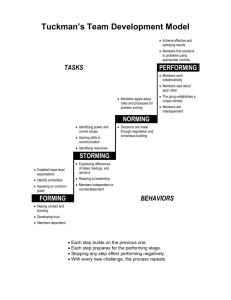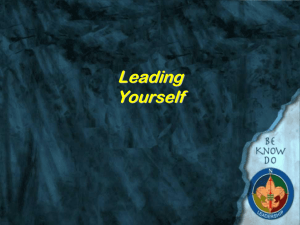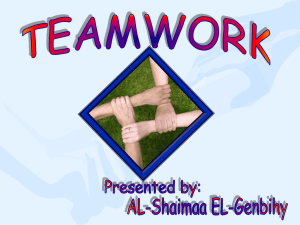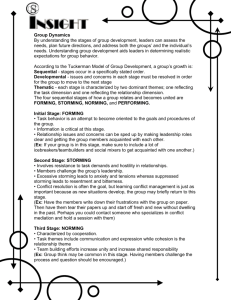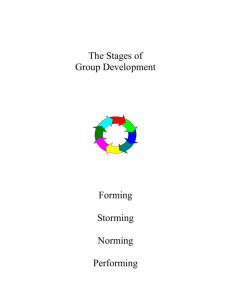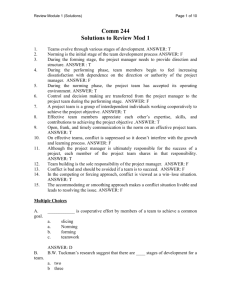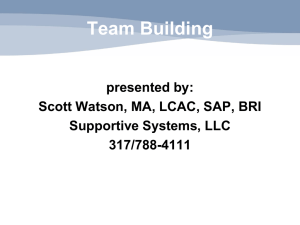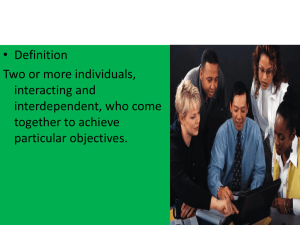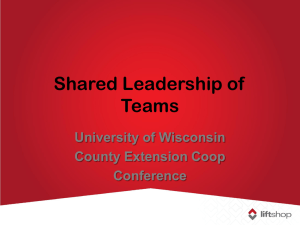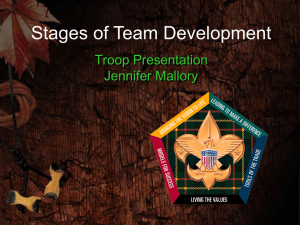ISQUA Webinar_April 2014_Phil Hassen
advertisement
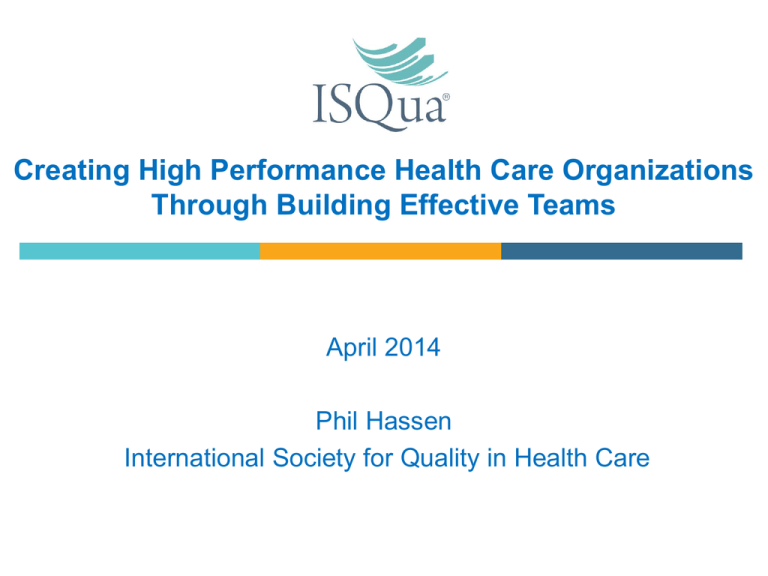
Creating High Performance Health Care Organizations Through Building Effective Teams April 2014 Phil Hassen International Society for Quality in Health Care Philip Hassen MPH, FCCHSE Past President, International Society for Quality in Health Care President, Canadian Network for International Surgery (2010-2012) CEO, Canadian Patient Safety Institute (2005-2010) Deputy Minister of Health, Ontario (2002-2004) President and CEO, Vancouver Coastal Health Authority (2000-2002) President and CEO, Providence Health Care (1997-2000) President and CEO, St. Joseph’s Health Care Centre (1988-1997) Other Senior Hospital Positions in Calgary and Toronto Session Purpose Increase your knowledge about team building and stages of team development Build your understanding about the constructs of teams and the challenges in making them effective Recognize that effective teams are essential for improving quality and service providing better care to patients and families What is Team Building? Is a philosophy of job design in which staff members are viewed as interdependent members of a team rather than as individuals who perform jobs/work Is built upon a culture which weighs more heavily on achieving team goals rather than individual ones “The whole is greater than the sum of its parts.” (Aristotle) 1+1 = 3 Team Building What are the Goals? Develop both the individual and team Increase team members understanding of: How the team currently works How to improve the way the team can work together in the future How to achieve better results Improve the team’s ability to collaborate, communicate, problem solve and plan together Increase quality, safety and efficiency in order to achieve intended team/organizational objectives Building Effective Teams What are some of the challenges? Relationships of trust Culture of "blame” Ineffective leadership Members agree on everything too quickly Building Effective Teams What are some of the challenges? Building teams within and across disciplines Increasing complexity of care delivery Lack of common goals Competing agendas Power struggles/conflicts What is Team Work? Achieving a common purpose through collaboration with others Using the talents of all members Individuals working together for a common purpose create a force All individuals contribute knowledge and expertise What are the Characteristics of Effective Teams? Work together with specific objectives in mind Members place the best interests of the team above individual interests Each team member has an important role and contributes uniquely to the work Use agreed-upon principles and processes such as decision-making and communication processes What are the Benefits of Effective Teamwork? Aids in decision making Improves communication Ensures that the work is accomplished efficiently and effectively Commits to the results Teamwork is the best countermeasure for fatigue 11 Common Team Building Exercises : Objectives Build healthy relationships and encourage team members to get to know each other both personally and professionally Increase Problem-solving Skills Strengthen Communications Build Trust What are some examples of Team Building Exercises? Through organized time away from daily work, teams can focus on the following exercises: Building Relationships - Use a sequence of questions and share in pairs or small groups. For example: share hopes & fears; share something personal such as a “little known fact” or “two facts (truths) about themselves and a lie”. Members introduce themselves to the rest of the group with three "facts" and others guess which one is a lie. Problem Solving Simulations – For example, Human Synergistics, a Canadian company provides a variety of simulations intended to demonstrate the importance of working together. In the “Desert Survival Simulation” there is a plane crash and team members must work together to survive the elements and make high quality decisions. What are some examples of Team Building Exercises? Through organized time away from daily work, teams can focus on the following exercises: Self Assessments – For example, use a well regarded assessment tool such as Myers Briggs Type Indicator (MBTI) to strengthen relationships and communication. With the information from the self-assessment team members gain more understanding about themselves and appreciate differences between people. All four MBTI types are equal; there is no best “Type” --Introversion/Extroversion; Sensing/Intuition; Thinking/Feeling; Judging/Perceiving. Group Dynamics Observations – To build trust, team members discuss how they interact with each other. For example, ask members to observe and record speaking patterns and track who speaks to whom and observe the flow of information and general communication patterns. Team Building Exercises Risks Team members may become cynical of the leader and/or organization if there are no meaningful changes or improvements after a team building exercise Events may be viewed as a waste of time and lead to decreased motivation and productivity if there is no lasting impact Fundamentals to Team Success Team leadership Team members Team relationships Organizational Culture Team Leadership Start with the Fundamentals Use Best Leadership Practices described by authors & researchers Kouzes & Posner 1. Model the Way 2. Inspire Shared Vision 3. Challenge the Process 4. Enable Others to Act 5. Encourage the Heart Team Leadership Assemble competent team members Match the talents of the members with the work that needs to be done Establish clear and inspiring team goals Know what the team needs to accomplish Believe in the team Team Leadership Encourage standards of excellence Develop work approaches, procedures and processes to ensure work is accomplished efficiently and effectively Invest in learning and development and be prepared to devout time and resources Build trust and member responsibility and accountability Coach individuals & the team Give feedback on team & individual performance Team Leadership Give Constructive Feedback Tips Be descriptive and specific Avoid generalizations Focus on behavior and state the facts Avoid exaggerations Give regular feedback and “catch” team members doing things right Be respectful & not threatening Use active listening Check for understanding & be prepared to discuss options Examples Positive Feedback : “I noticed that you finished the project two days ahead of schedule and so we have some flexibility and can catch our breath. I wonder if you would be willing to share your approach to project management with others?” Critical Feedback: “I noticed that you were 30 minutes late for clinic and we are delayed in seeing some people who were scheduled. We will not be able to get to the meeting at the end of the day.” What do you suggest we do now? Team Leadership Leaders recognize that approaches need to be flexible and appropriate to the team’s stage of development As we next review the stages of team development, consider the implications to the delivery of the quality and safety of care and service Stages of Team Development Overview Forming Storming Norming Performing Stages of Team Development (Tuckman, 1970) Describes characteristics and practical approaches for each stage of development Stages of Team Development Forming Forming Storming Norming Characteristics Hesitant participation Roles and responsibilities are unclear Exchange of functional information High dependence on leader for direction Performing Team Formation What is my role? How can I make a unique contribution? What are the goals? Stages of Team Development Forming Forming Storming Norming Performing Practical Approaches Clarify roles & goals Get acquainted and orient members to the task & people Establish group agreements Identify information and resources Stages of Team Development Storming Forming Storming Norming Performing Characteristics Resistance to the task as members realize it is more difficult than imagined Formation of conflicting factions Polarization of issues and lack of unity Leader may be challenged by team members Stages of Team Development Storming Forming Storming Norming Performing Practical Approaches Use active listening Be flexible & open-minded Clarify the issues, share views & feelings respectfully Apply understanding of different approaches to conflict Stages of Team Development Norming Forming Storming Norming Performing Characteristics Development of cohesive team Engage in brief fun & playfulness Co-operation & commitment is high Acceptance of others & respect for individual differences Stages of Team Development Norming Forming Storming Norming Performing Practical Approaches Give & receive constructive feedback Seek & give opinions & perspectives Focus on problems/issues (not the person) Leader coaches and enables action Stages of Group/Team Development Performing Forming Storming Norming Characteristics Shared vision & values Strong interdependence of task & relationships Able to resolve disagreements positively Act on opportunities for change & improvement Team has a high degree of autonomy Performing Stages of Group/Team Development Performing Forming Storming Norming Practical Skills Use participative decision making Apply problem solving approaches Stay open to new ideas Delegate, support & encourage Performing Summary Stages of Team Development Forming • • Clarify roles & goals Establish team agreements/expectations Storming • • Address differences & face challenges Use active listening Norming • • Give & receive constructive feedback Focus on problems & issues Performing • • Use participative decision-making approaches Support and encourage the team “Coming together is a beginning. Keeping together is progress. Working together… achieving results … is success.” Henry Ford Cross Functional & Interdisciplinary Teams “Interdisciplinary collaboration is considered key to the visionary 21st century health care paradigm where teams function effectively to optimize safety and deliver high quality care.” (Institute of Medicine, 2001) Summary : Capabilities of Effective Teams Clarity of Outcomes Commitment Competence Collaboration Communication Coordination Change Oriented Cross Functional & Interdisciplinary Teams Necessary for Large Scale Change Usually used for large & complex tasks Teams are usually more diverse More connected via technology Typically composed of more highly educated people Harder to manage Often more diversity of views; thus more prone to disagreement and deadlock Used selectively, for leading edge and innovative creative-type changes Role of leader is more dynamic and thus requires a very skilled leader Some Examples My Experience with Team Building Developing senior staff through modified responsibilities to achieve common mission, vision, values and principles of operation AND becoming effective team members/leaders Improving patient/family care processes by teams collaborating to reduce steps and hand-offs to enhance surgical care resulting in improved quality and efficiency Addressing major care problems in a complex community/multi-hospital organization by understanding roles and enabling team members to gain new perspectives to improve across the continuum for patient/client care Cross Functional Teams Hospital Community (Physicians & Homecare) The overwhelming majority of untoward events involve communication failure Somebody knows there’s a problem but can’t get everyone “in the same movie” 38 Communication Patient Safety Practices In 2008 Accreditation Canada established Patient Safety areas and Required Organizational Practices (R.O.P.’s) as a mandatory element of all accreditation surveys R.O.P.: Employ effective mechanisms for transfer of information at interface points, including shift changes, discharge, and patient/client movement between health care services and sectors, and implement improvements. Evidence: Mechanisms for transfer of information are consistently used (For example: checklists, transfer forms, huddles). Do Effective Teams Make a Difference? Better communication Improved co-ordination and collaboration Increased capability to achieve goals and make change Quality and Safety Improve Final Thoughts: The Road Ahead “We are on a journey−a journey that will take enormous efforts to change. It is clear that improvement in patient safety and quality will take time, but the time for change is now. Our patients, residents, families and communities depend on providers to work as teams to achieve improved care and services.” - Hassen & Dingwall 2008 Selected Resources Teamwork and Team Building. Corporate Training Materials. corporatetrainingmaterials.com Effective Teamwork in Healthcare: Research & Reality. D. Clements, M. Dault & A. Priest. Heathcare Papers. Vol. 7. Special Issue The Wisdom of Teams: Creating the High-Performance Organization. J.R .Katzenbach & D.K .Smith. (1993) The Team Handbook. 3rd Edition. P. Schultz, B. Joiner & B. Streibel. (2003) The Leadership Challenge. 4th Edition. J. Kouzes & B. Posner (2007) When Teams Work Best. F. LaFasto & C. Larson. (2001) Rx for Hospitals. Philip Hassen. (1993) Creating High Performance Health Care Organizations Through Building Effective Teams ~Your Question & Comments Please ~ Thank you!
